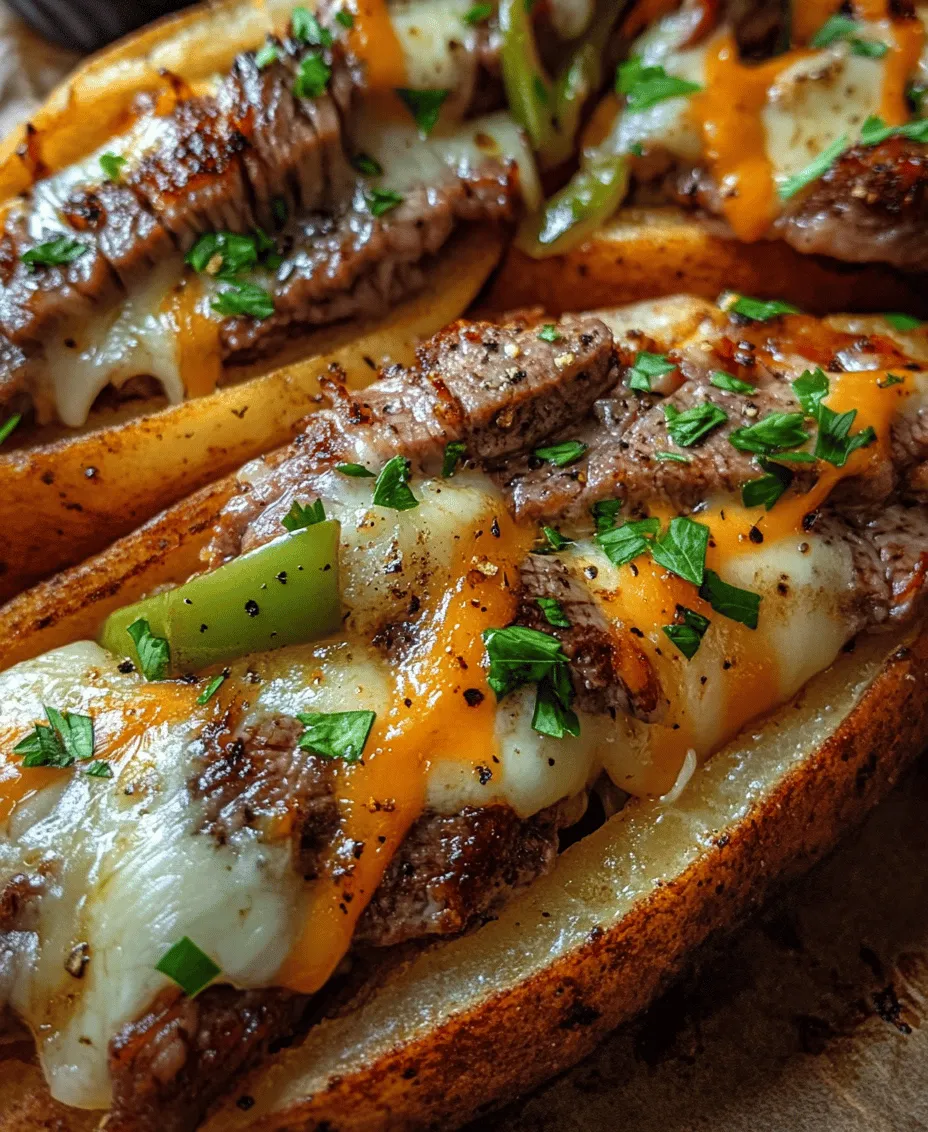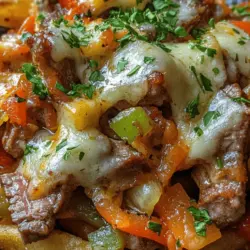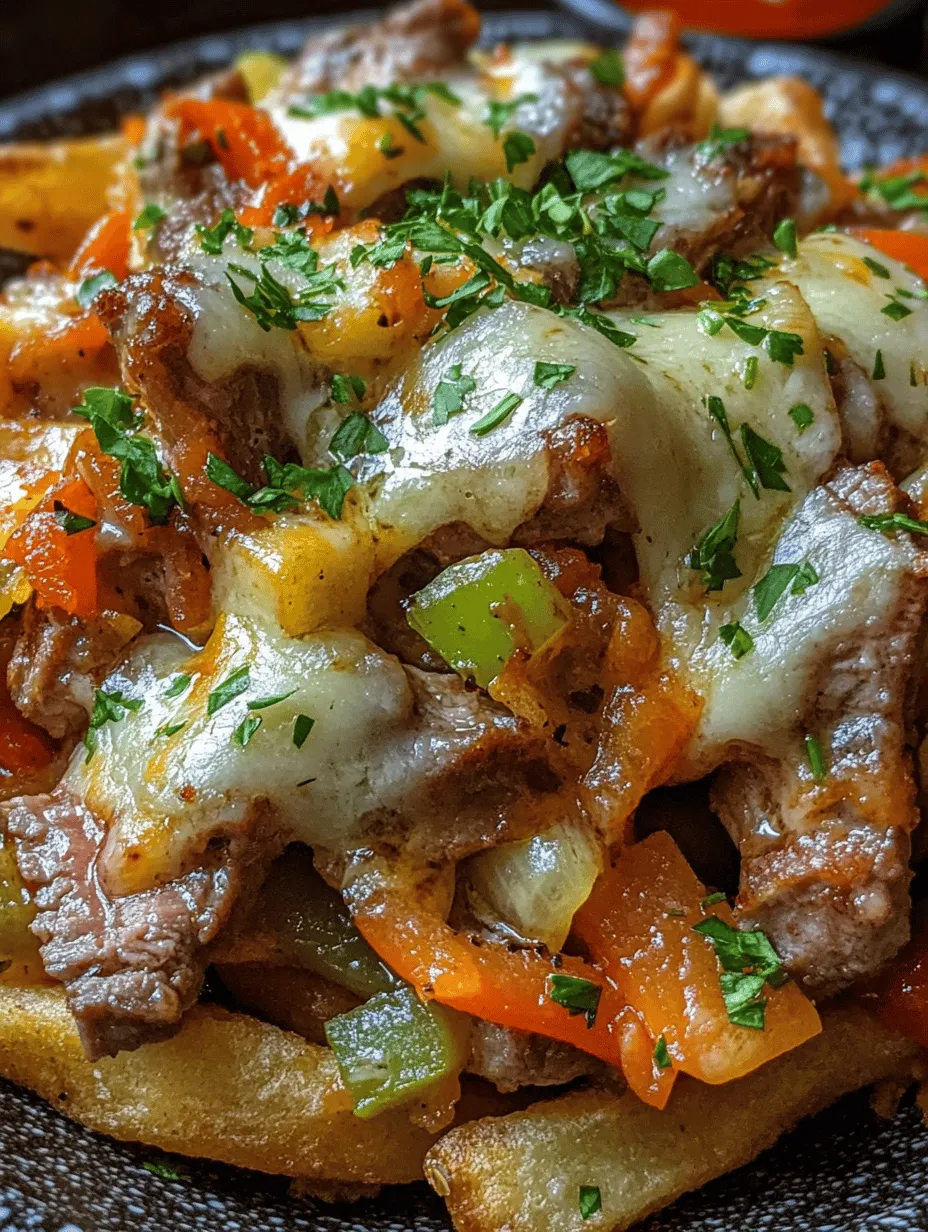Introduction
Philly Steak Cheese Fries are a mouthwatering fusion of two beloved comfort foods—the classic French fry and the iconic Philly cheesesteak. This dish brings together crispy, golden fries topped with savory, tender ribeye steak, melted cheese, and an array of delectable toppings that can be customized to suit your palate. The appeal of Philly Steak Cheese Fries lies in their ability to deliver an indulgent experience that satisfies cravings while also allowing for gourmet flair.
There’s something special about crafting your own version of this dish at home. Homemade Philly Steak Cheese Fries not only ensure that you control the ingredients for optimal flavor but also give you the freedom to customize every aspect—from the type of cheese you use to the seasonings that enhance each bite. This versatility makes it a fantastic option for gatherings, game days, or cozy nights in.
Understanding Philly Steak Cheese Fries
Origin and History of the Dish
The roots of Philly Steak Cheese Fries can be traced back to the renowned Philly cheesesteak, a sandwich that originated in Philadelphia, Pennsylvania, in the early 20th century. This iconic sandwich was invented by Pat and Harry Olivieri, who created it as a quick meal for themselves and later decided to sell it from their hot dog stand. The combination of thinly sliced ribeye steak, melted cheese, and sautéed onions became an instant hit and eventually grew into a staple of Philadelphia culture.
While the cheesesteak is traditionally served as a sandwich, the concept of transforming its core ingredients into a hearty fry dish emerged as a creative twist on the classic. The fusion of crispy fries with the rich flavors of the cheesesteak has since gained popularity across the United States, especially in sports bars and casual dining establishments.
Popularity in American Cuisine
Philly Steak Cheese Fries have carved out a niche in the realm of American cuisine, embracing the comfort food trend that thrives on indulgence and flavor. As food enthusiasts seek out new ways to enjoy familiar tastes, this dish has become a favorite among many. From food trucks to upscale restaurants, variations of Philly Steak Cheese Fries can be found on menus nationwide, each offering unique spins that cater to local tastes.
The dish’s popularity can be attributed to its shareability, making it a perfect appetizer for parties and gatherings. Whether you’re watching the big game or hosting a casual get-together with friends, Philly Steak Cheese Fries are sure to please a crowd.
Variations of the Dish Across Different Regions
As with many beloved dishes, Philly Steak Cheese Fries have inspired a range of regional variations. In some areas, you might find additional toppings such as jalapeños, bacon, or even barbecue sauce, which add a new layer of flavor and excitement. Other adaptations may incorporate different types of cheese—while provolone and Cheddar are classic choices, some recipes might call for pepper jack for a spicy kick or even blue cheese for a more robust flavor profile.
In addition, the preparation methods can vary significantly. Some cooks opt for deep-frying the potatoes, while others prefer baking them for a healthier twist. The choice of potatoes themselves can also differ, with some variations using sweet potatoes for a unique flavor and sweetness. Regardless of the specific adaptations, the heart of the dish remains the same: a hearty blend of fries, steak, and cheese that promises satisfaction.
Ingredients Breakdown
When it comes to crafting the perfect Philly Steak Cheese Fries, each ingredient plays a crucial role in achieving the right balance of flavors and textures. Here’s a closer look at the essential components of this dish:
Description of Each Ingredient and Its Role in the Recipe
1. Russet Potatoes: The foundation of this dish, russet potatoes are known for their high starch content, which results in a fluffy interior and crispy exterior when cooked. Their size and shape make them ideal for fries, allowing for a satisfying crunch.
2. Ribeye Steak: High-quality ribeye steak is key to creating a tender and flavorful topping. This cut is well-marbled, ensuring that it remains juicy and rich in flavor when cooked. The marbling also enhances the overall taste of the dish, making it a standout feature.
3. Cheese: Traditionally, provolone cheese is the cheese of choice for Philly cheesesteaks due to its creamy texture and mild flavor. Cheddar cheese is often added for its sharpness and gooey melting properties. Combining these cheeses can elevate the overall richness and complexity of the dish.
4. Fresh Herbs and Seasonings: Fresh herbs like parsley or chives can add a burst of color and freshness to the dish. Seasonings such as salt, pepper, and garlic powder enhance the flavor profile, bringing all the ingredients together harmoniously.
5. Sautéed Onions and Peppers (optional): For those looking to add more depth to their fries, sautéed onions and bell peppers can be included. These ingredients provide sweetness and additional texture, reminiscent of the classic cheesesteak experience.
Importance of Using High-Quality Ribeye Steak
The steak is the star of this dish, so selecting a high-quality ribeye is essential. When choosing ribeye, look for cuts that have good marbling and a bright red color. The marbling indicates fat content, which contributes to the steak’s juiciness and flavor. A well-cooked ribeye will be tender and melt-in-your-mouth, making each bite of your Philly Steak Cheese Fries a memorable experience.
Selection Tips for Potatoes: Russet vs. Other Varieties
While russet potatoes are the preferred choice for fries, other varieties can also be used depending on your preference. For instance, Yukon Gold potatoes offer a creamy texture and buttery flavor, while sweet potatoes provide a slightly different taste and added sweetness. If you choose to experiment with these alternatives, keep in mind that cooking times may vary. Ensure that you adjust your baking or frying methods accordingly to achieve the desired crispiness.
Exploring Cheese Options: Provolone and Cheddar
When it comes to cheese, the classic provolone and cheddar combination is hard to beat. Provolone’s smooth melting quality pairs wonderfully with the sharpness of cheddar, creating a deliciously gooey topping. However, don’t hesitate to explore other cheese options! Pepper jack adds a spicy kick, while mozzarella can provide a stretchy, melty texture. Feel free to mix and match cheeses to find the perfect blend that suits your taste.
Fresh Herbs and Seasonings for Added Flavor
Incorporating fresh herbs and seasonings can take your Philly Steak Cheese Fries to the next level. A sprinkle of freshly chopped parsley or chives right before serving adds a pop of color and freshness. Additionally, a dash of garlic powder or onion powder can deepen the flavor, making each bite more delicious. Don’t shy away from experimenting with your favorite spices; just remember to balance them so they complement rather than overpower the dish.
Preparation Steps for Perfect Fries
Creating the perfect Philly Steak Cheese Fries involves meticulous preparation and attention to detail, especially when it comes to the fries themselves. Here’s how to ensure your fries turn out crispy and delicious:
Importance of Precooking Preparation
Before you dive into the cooking process, it’s important to prepare your ingredients properly. This includes washing and cutting your potatoes, seasoning your steak, and gathering all necessary supplies. Proper preparation not only streamlines the cooking process but also ensures that each component is cooked to perfection.
Detailed Instructions on Washing and Cutting Potatoes
1. Washing: Begin by thoroughly washing your russet potatoes under cold running water to remove any dirt or debris. It’s essential to scrub the skin gently with a vegetable brush to ensure they’re clean, as the skin contributes to the fries’ texture and flavor.
2. Cutting: Once washed, dry the potatoes with a paper towel. To cut them into fries, slice each potato in half lengthwise, then cut each half into uniform strips about ¼ inch thick. The key to evenly cooked fries is to ensure that they are all roughly the same size.
Techniques for Achieving the Perfect Fry Texture
Achieving the perfect fry texture involves a few key techniques:
– Soaking: After cutting the potatoes, soak them in a bowl of cold water for at least 30 minutes. This step helps to remove excess starch, resulting in crispier fries.
– Drying: After soaking, drain the potatoes and pat them dry with a clean kitchen towel. Removing moisture is crucial for achieving that sought-after crispiness.
– Coating: For an extra crispy finish, toss the dried potatoes with a light coating of cornstarch or flour before cooking. This will create a crispy outer layer while keeping the insides fluffy.
Baking Tips for Optimal Crispiness
To bake your fries to perfection, follow these tips:
1. Preheat the Oven: Preheat your oven to 425°F (220°C). A hot oven is essential for achieving crispy fries.
2. Spacing: Spread the fries in a single layer on a baking sheet lined with parchment paper. Avoid overcrowding, as this can cause them to steam rather than crisp up.
3. Flipping Method: Bake the fries for about 25-30 minutes, flipping them halfway through the cooking time to ensure even browning on all sides. Keep an eye on them during the last few minutes to prevent burning, as oven temperatures can vary.
By following these preparation steps, you’ll be well on your way to creating the ultimate Philly Steak Cheese Fries, bursting with flavor and texture. In the next part of this article, we will delve into assembling the dish, cooking the steak, and adding those delicious toppings that make this recipe truly irresistible.

Cooking the Steak Mixture
To create the perfect Philly Steak Cheese Fries, the steak mixture is paramount. Begin by selecting the right cut of meat; ribeye or sirloin works best due to their marbling and flavor. Cut the steak into thin strips against the grain. This method ensures tender bites that will melt in your mouth.
1. Sautéing Techniques: Heat a skillet over medium-high heat and add a tablespoon of oil. Once the oil is shimmering but not smoking, add the steak strips in a single layer. Avoid overcrowding the pan; if necessary, cook the steak in batches to achieve a good sear. Searing the meat locks in juices and creates a delicious crust. Cook the steak for about 3-4 minutes, flipping once to ensure even cooking. The goal is to get a nice brown color, while keeping the inside tender and juicy.
2. Sautéing Vegetables: Once the steak is nearly cooked to your desired doneness, remove it from the skillet and set it aside. In the same skillet, add sliced bell peppers and onions. Sauté these vegetables for about 4-5 minutes until they become soft and slightly caramelized. This timing is crucial; you want them tender but not mushy. If you prefer a bit of crunch, you can cook them for a shorter time.
3. Flavor Enhancement: As the vegetables cook, season with salt, pepper, garlic powder, and a splash of Worcestershire sauce for an added depth of flavor. This combination enhances the natural sweetness of the vegetables and complements the savory steak. Stir the mixture well to ensure the seasonings coat everything evenly. After adding the seasoning, return the cooked steak to the pan, mixing everything together for about 1-2 minutes until the flavors meld.
4. Timing in Cooking: It’s essential to time your cooking so that everything finishes simultaneously. The steak should be cooked just right—medium-rare to medium is ideal, as it will continue to cook slightly after being combined with the vegetables. By keeping the steak and veggies in the pan together for a brief period, you allow the flavors to infuse without overcooking the meat.
Combining and Melting the Cheese
With the steak mixture ready, it’s time to bring everything together and add the cheese, which is the pièce de résistance of this dish.
1. Layering Ingredients: Start by preheating your oven to 375°F (190°C). Take a large oven-safe dish and layer a generous portion of fries at the bottom. Next, spoon the steak and vegetable mixture evenly over the fries. This layering method ensures that every fry is topped with the delicious steak and veggie blend.
2. Achieving the Ultimate Cheese Melt: Now for the cheese. Opt for provolone or Cheddar cheese for that authentic Philly cheesesteak flavor. Shred the cheese to ensure it melts evenly. Sprinkle a generous amount over the steak mixture. For an extra touch, consider mixing in some mozzarella for a gooey, stretchy texture. Place the dish in the preheated oven and bake for about 10-15 minutes, or until the cheese is bubbly and golden.
3. Visual Cues for Doneness: Keep an eye on the cheese; it’s ready when it’s melted and begins to brown slightly at the edges. If you want a more charred flavor, you can switch to broil for the last 2-3 minutes, but watch it closely to prevent burning.
Serving Suggestions
Now that your Philly Steak Cheese Fries are ready, it’s time to present this comfort food masterpiece.
1. Presentation Ideas: Serve the dish straight from the oven in the same dish for a rustic feel. For a more refined presentation, use a large platter to display the fries, topped with steak and cheese. Garnish with fresh chopped parsley or chives for a pop of color.
2. Suggested Accompaniments: Pair your fries with a variety of dipping sauces. Classic choices include ranch dressing, spicy ketchup, or a tangy BBQ sauce. You could also serve with a side of pickle slices or jalapeños for a zesty kick. For a fresh touch, a simple side salad with a vinaigrette can balance the richness of the fries.
3. Customization Options: Feel free to get creative with toppings! You could add sautéed mushrooms, jalapeños, or even a drizzle of hot sauce for added heat. For a unique twist, try using different cheeses or incorporating other proteins like grilled chicken or pulled pork.
Nutritional Information
While Philly Steak Cheese Fries are undeniably indulgent, understanding their nutritional content can help you enjoy them guilt-free.
1. Calorie Content: A typical serving of this dish can range from 700 to 1,000 calories, depending on portion size and toppings. It’s essential to be mindful of how much you serve, especially if you’re watching your caloric intake.
2. Balancing Indulgence: To maintain a balanced diet, consider enjoying this dish as an occasional treat rather than a regular meal. Incorporate healthier sides, like steamed vegetables or a light salad, to counterbalance the richness of the fries.
3. Healthier Substitutes: If you’re looking to lighten up the dish, consider using sweet potato fries instead of regular fries for added fiber and vitamins. You can also opt for lower-fat cheese options or reduce the amount of cheese used. Additionally, using leaner cuts of meat or even plant-based alternatives can significantly lower the calorie count while still providing that satisfying flavor.
Conclusion
Philly Steak Cheese Fries are a delightful blend of flavors and textures that make for a perfect comfort food option. This dish’s versatility allows you to customize it to your liking, ensuring it can cater to various palates. Whether you choose to follow the traditional recipe or experiment with your own twists, you’ll surely create a crowd-pleaser that everyone will love.
As you dive into making this dish, remember that the joy of cooking lies in experimentation and personalization. Don’t hesitate to add your special touch, whether that be a unique spice blend, a special sauce, or additional toppings. Enjoy the process, and celebrate the creation of a homemade comfort food masterpiece that brings warmth and satisfaction to your table.


